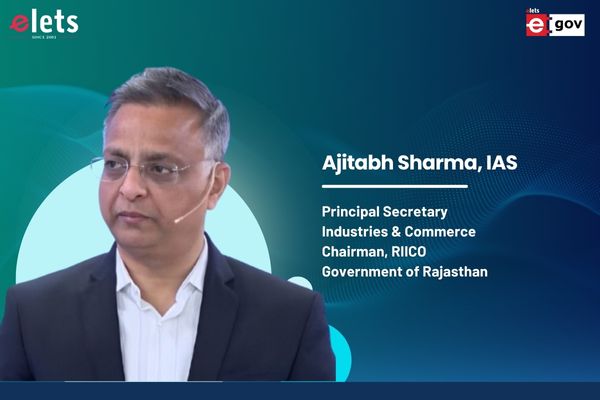
The role of IT has evolved from technology experts to visionaries responsible for business growth, while technological advancements like the BIM-first strategy, iDREAMS Project, and in-house project management system SPEED have transformed the traditional railway system into a smart and efficient network highlights Ritu Singh, General Manager – IT, National Capital Region Transport Corporation (NCRTC) in an exclusive interaction with Nisha Samant of Elets News Network (ENN).
What are the key focus areas that you envision for NCRTC’s IT department in driving the further advancement of smart railways?

NCRTC has been at the forefront of leveraging cutting-edge technologies for the successful implementation and efficient operations of the RAPIDX system. Taking advantage of being a greenfield project, NCRTC has implemented IT systems right from the planning stage of the project to the project management, project monitoring, interface management, project-to-operations switchover and asset management and maintenance. With an objective to build a digital twin of the complete system, the NCRTC has conceptualized a well-planned IT roadmap. Key focus areas in this journey are:

- An integrated approach is key to the success of any system as systems working in siloes seize to deliver intended advantages as the ecosystem grows.
- Real-time data management: For a system to be intelligent, the availability of complete data pertaining to the assets including asset definition, asset condition, faults etc. should be available in real-time.
- Enterprise-wide uniform strategy: Railway systems consist of multiple sub-systems and assets. The co-relation among these sub- systems is an essential component which should be considered while analyzing the asset data. For example, any fault in the track is correlated to the rolling stock asset condition as well. Hence, an Enterprise-wide uniform IT strategy is capable of efficiently analyzing real-life conditions.
How do you see the role of IT evolving to meet the growing demands and challenges of the transportation industry?

IT strategy is no more restricted to the IT department only. It is now an integral part of project management strategy. Similarly, the role of IT has also evolved from just technology experts to the technocrats who are responsible for having a larger vision for business growth and enhancements. The transportation industry in general and the Railway industry in specific gives lots of opportunities as well as challenges to IT due to its impact on the masses and reach across large geographical regions.

Could you provide us with an overview of your role and responsibilities in driving the IT initiatives for smart railways?
As General Manager, IT in NCRTC my role is to define the IT roadmap of the organization and implement the same. In the current cyber world, my responsibility to ensure cyber security in the organization is also crucial. While driving IT initiatives in NCRTC, my focus is always on a larger vision to see interfacing with other systems such as GIS, BIM, S&T systems, Building management systems etc.
What are the key technological advancements and innovations that you have implemented to transform the traditional railway system into a smart and efficient network?
One of the most-critical technological advancements and innovations implemented by NCRTC is the BIM-first strategy. Conventionally 2D platforms were used to manually draw station layouts, viaducts, etc. This process of manual drafting was time-consuming as well as the chances of error were manifold as even a small change had to be replicated manually across all drawings, documents, etc. NCRTC has enthusiastically adopted Building Information Models which is a 3D representation of construction drawings along with complete metadata associated with the objects and layout in the model.
Also Read | Driving Decarbonisation in Railways: Hitachi Vantara’s Next-Generation Power Solutions
Another major transformational implementation done by NCRTC is iDREAMS Project which is Enterprise- wide Real-time Enterprise Asset Management System which consumes data from BIM and prepares digital twins for the complete system. Lastly, I would also like to mention the in-house grown project management system SPEED which has been effectively used in NCRTC to ensure that the project is completed within time and cost budget.
Can you provide an overview of the data management practices and privacy measures implemented by you to handle and protect the vast amount of data generated by smart railway systems?
NCRTC is very soon going to commission the priority section of RAPIDX services. It is understood that a huge volume of data will be generated from various IT and OT sub-systems of RAPIDX. NCRTC is planning to implement a data lake to ingest this data for the first few years and then it will embark upon the journey of data analytics to extract meaningful insights from the historical data collected. Hence, at present the focus is on data collection from every corner of the project possible, including asset maintenance data. Predictive maintenance is also implemented as part of the iDREAMS project. As far as data privacy and cyber security are concerned, NCRTC is conscious of the fact that OT systems are most critical. Hence, any interfacing with these systems is being done through hardware-based unidirectional gateways. Such steps are being taken to ensure air-gap in the architecture and security of the Operational systems. Even for IT systems, which are mostly deployed on cloud infrastructure, a proper security framework is built to ensure the privacy of data generated from these systems.
Be a part of Elets Collaborative Initiatives. Join Us for Upcoming Events and explore business opportunities. Like us on Facebook , connect with us on LinkedIn and follow us on Twitter, Instagram.
"Exciting news! Elets technomedia is now on WhatsApp Channels Subscribe today by clicking the link and stay updated with the latest insights!" Click here!













